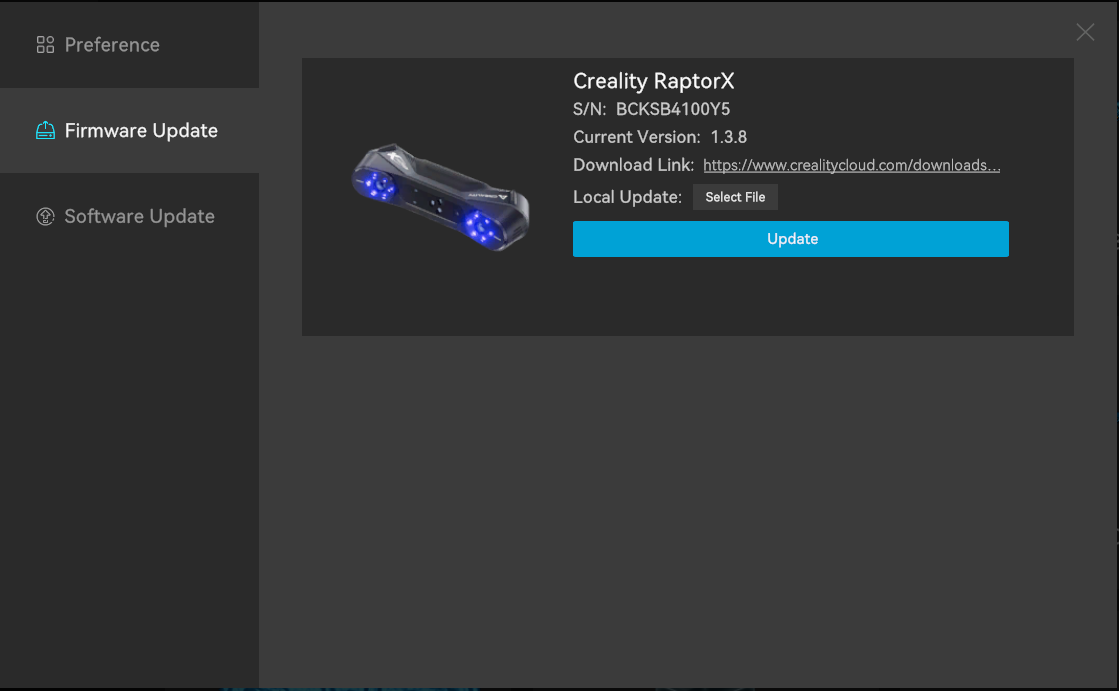¶ Installation
¶ Software
https://www.crealitycloud.com/software-firmware/software/creality-scan
¶ Firmware
https://www.crealitycloud.com/software-firmware/other/type-26
(* Normally, you don't need to download the firmware manually. You can click Install in the prompt of the latest version of the software. Only if the installation fails, you need to try to install the firmware manually.)
¶ Windows 10/11 (64-bit)
Recommended configuration: CPU i7-Gen8 and above, Nvidia graphics card, 16GB RAM or above
Minimum configuration: CPU i5-Gen8 and above, 8GB RAM or above.
Software version: Creality Scan ≥ v3.1.22
¶ macOS
Recommended configuration: CPU Apple M1/M2/M3/M4 series processor, 16G RAM or above
System version macOS 11.7.7 and above (Big Sur/Monterey/Ventura)
Minimum configuration: CPU i5-Gen8 and above, 8GB RAM or higher.
System version macOS 10.15.7 and above (Catalina/Big Sur/Monterey/Ventura)
Software version: Creality Scan ≥ v3.1.22
¶ Mobile Phone
Recommended moblie phone models(Same for Rator X and Raptor pro)
(For iPhone, it recommend 16G RAM or above.)
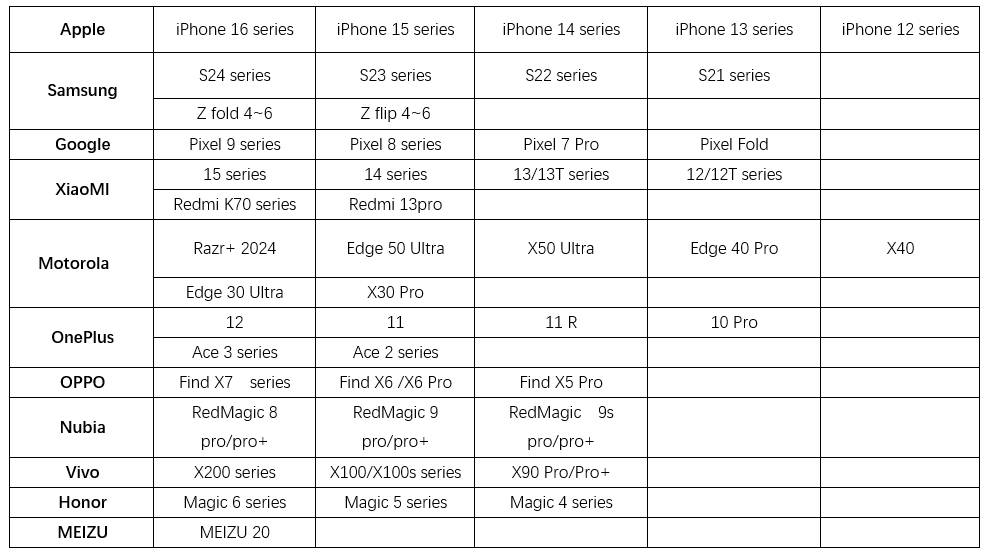
¶ Windows & Mac software guidance
¶ Home page
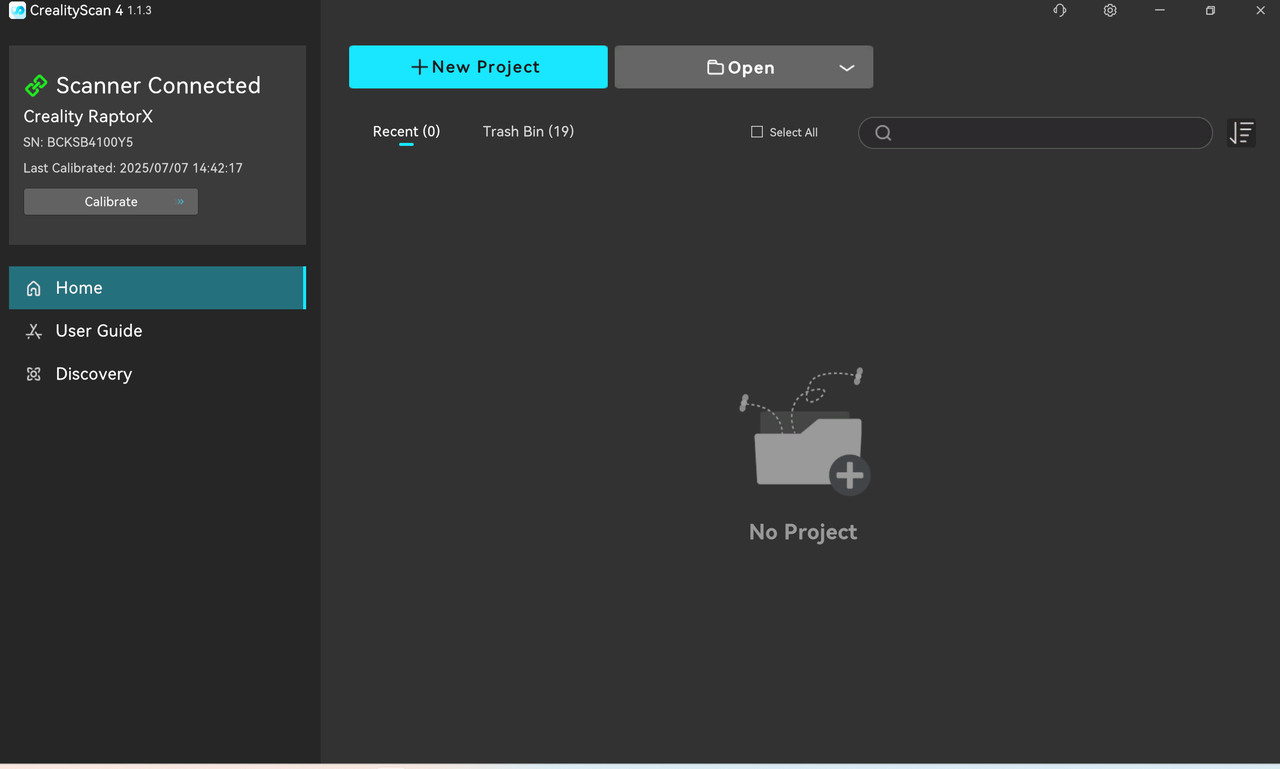
Check whether the scanner is connected successfully in the inforbox on the left side of the homepage. It is recommended to use USB3.0 to connect the scanner. The infobox will display basic device information and support entering the calibration page.
① The left column contains three entrances: "Home", "User Guide" and "Discovery". The settings button on the top right supports switching languages.
② The middle area lists the recently opened multi-projects under "Recent". Click the corresponding picture to open the corresponding multi-project. The "Trash Bin" can restore or permanently delete a multi-project, and the "Search Bar" can search for existing projects.
③ Click "New Project" to start a new scan. Click "Open" and select "Open Project or Model" to import multi-projects (.obp format) or view models (.stl, .obj, .ply format) from a local folder. Click "Import from Smart Phone" to import projects from the mobile APP through the LAN, and be sure to keep the mobile phone and computer in the same LAN.
¶ Quick Calibration
Reference Videos:
Raptor series: https://www.youtube.com/watch?v=T1gTWuQRO-c
After the device is connected, enter through the calibration button in the left infobox of the homepage.
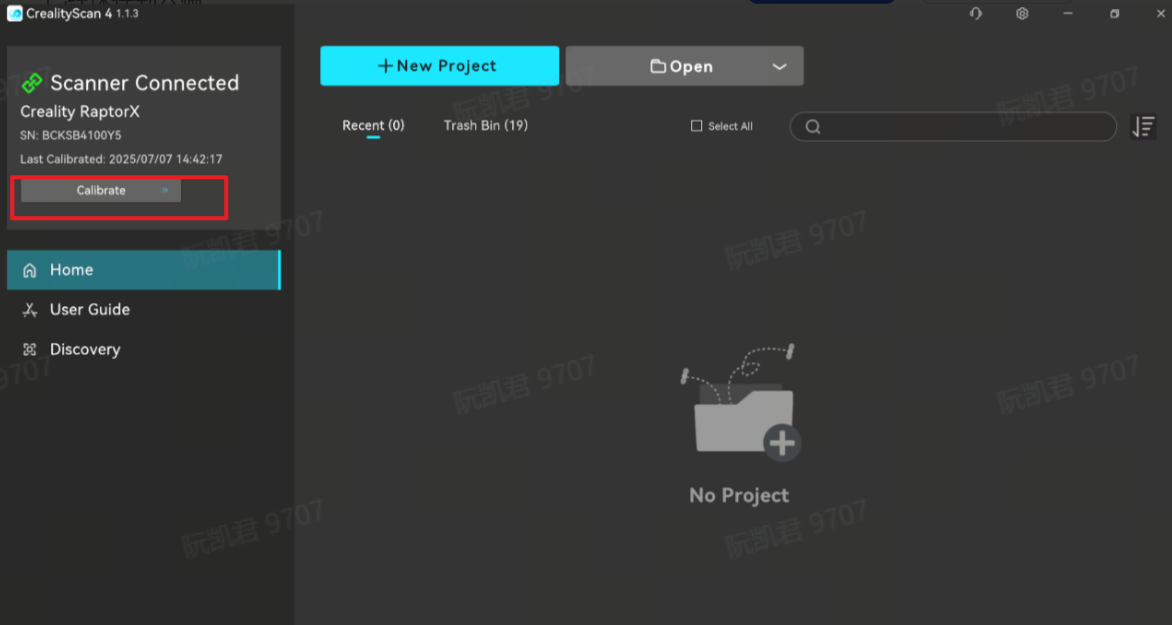
When using it for the first time, be sure to aim it at the back of the calibration board that comes with the package to scan the QR code.
After entering the acquisition process, be sure to aim the scanner at the front of the calibration board and move the scanner according to the guidance.
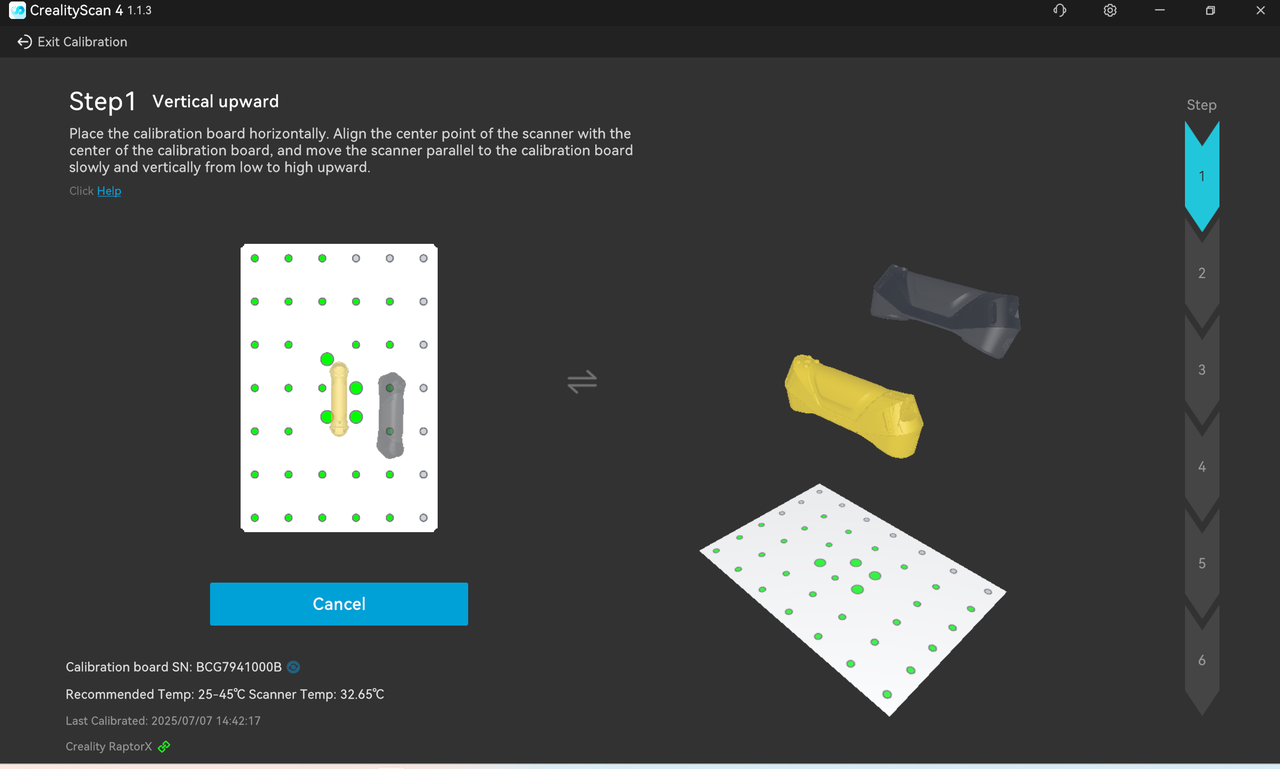
The left and right sides are process guidance areas, showing the pose and angle requirements for the current acquisition. Pay attention to matching the orientation of the scanner and calibration board according to the diagram. When placing the calibration board on the table, make sure the arrow is facing upwards.
The bottom left shows the calibration board number and scanner temperature. Please make sure to perform calibration within the appropriate temperature range. The rightmost side shows the current step.
The guidance areas are used to guide the scanner's pose in real time. As pose acquisition is completed, the corresponding steps on the right side illuminate one by one.
- The left guidance area primarily directs the scanner's forward, backward, left, and right movements.
- The right guidance area primarily guides the scanner's height adjustment.
During calibration, the scanner is moved to the target position according to the guidance, ensuring that the two scanner models overlap and pose acquisition is complete, as shown in the figure below.
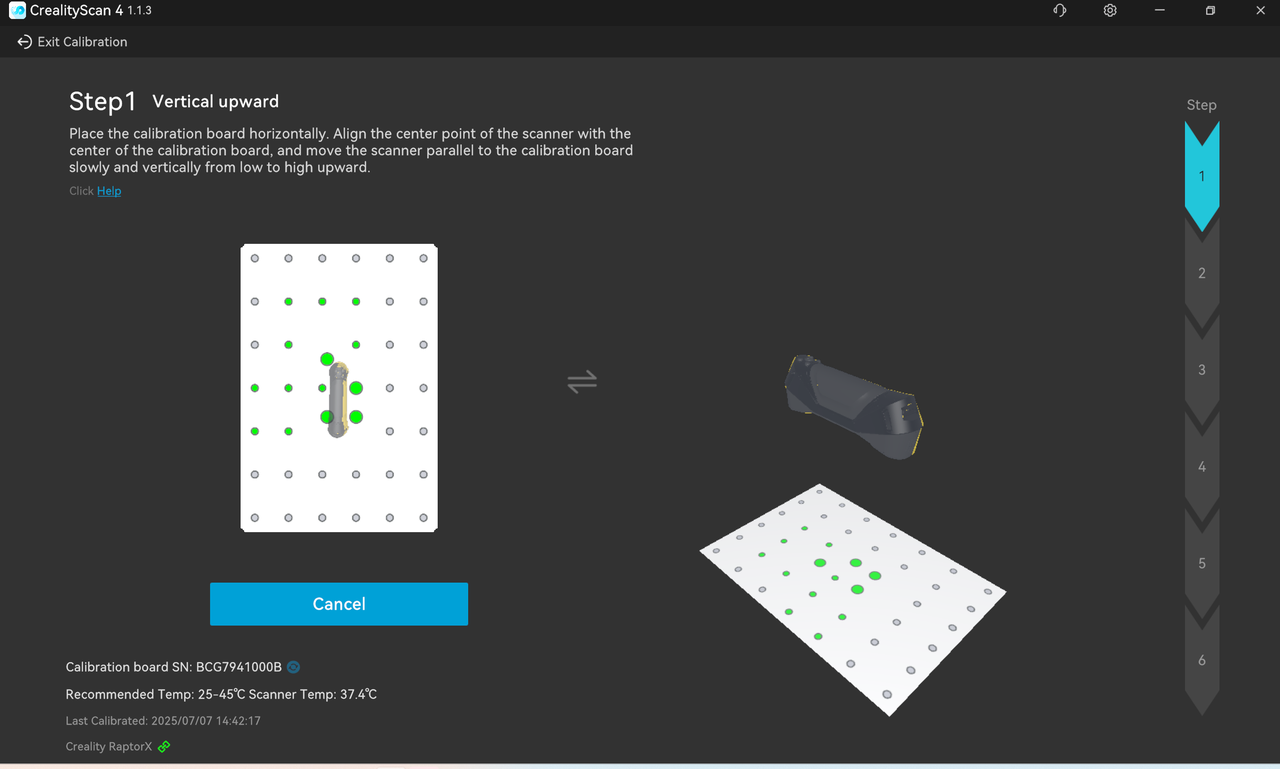
After the current pose acquisition is completed, it will automatically enter the next pose acquisition. Please follow the instructions to move the scanner repeatedly to complete the acquisition of all positions in the entire process. After the acquisition is completed, it will automatically enter the calibration process. Please wait patiently for the calibration results. After the calibration is successful, start scanning to experience high-quality scanning.
¶ Scan Settings
Click "New Project" on the homepage, as shown below:

Enter the project name in the pop-up bar, select the folder path, and then click the "OK" button, as shown below:
It's recommended to use the name of the scanned object as the project name to improve recognition.

After clicking the page, you will enter the scanning settings page.
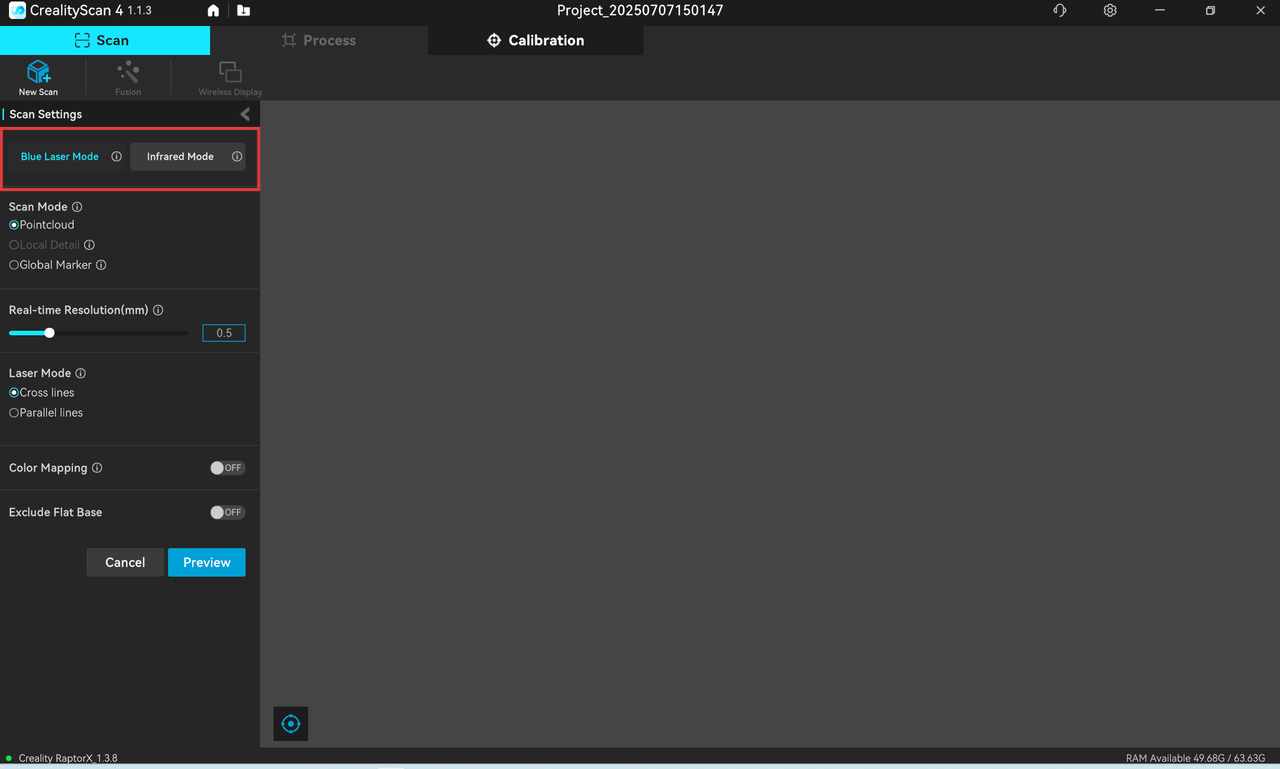
¶ Blue Laser Mode / Infrared Mode Selection
The scan mode is divided into "Blue Laser Mode" and "Infrared Mode".
- To choose between blue laser mode and infrared mode depends on specific scanning requirements and object characteristics.
- Generally speaking, blue laser mode is suitable for scanning objects with rich details and unusual surface materials. It is particularly suitable for industrial manufacturing and inspection scenarios where high precision is required and circular reflective markers are needed for scanning and tracking.
- Infrared mode is suitable for fast scanning and supports geometry tracking (without markers, suitable for scanning objects such as human, face, sculpture, and cultural relic), texture tracking, and marker tracking. It excels in face/body scanning (infrared structured light is invisible and harmless to the human eye), medical rehabilitation, digitization of cultural relics and artworks, and scenarios sensitive to ambient light.
¶ Tracking Mode Selection
- Geometry Mode: Tracks objects based on their geometric shape. Geometry mode is recommended for objects with rich, irregular geometric features.
- Texture Mode: Suitable for objects with rich, irregular textures but limited geometric features (such as patterned vases and paintings).
- Marker Mode: Use marker mode for scanning objects with neither clear geometric nor texture features. This mode requires reflective circular markers placed on or around the object to assist in tracking. For large objects, markers with an inner diameter of 6mm should be used, while for small objects, markers with an inner diameter of 3mm can be used.
¶ Point Cloud / Global Marker Scanning
For medium-to-large objects (≥250×250×250mm²), it is recommended to scan the global marker first, then the point cloud. This saves memory space, captures object features faster, and achieves higher model accuracy.
¶ Exclude Flat Base
Click to enable or diable this feature. This feature takes effect immediately and removes surfaces that may affect the scan results or are unnecessary. If the object is particularly small and difficult to scan, such as just a few centimeters, it is recommended to apply markers to the desktop and then scan in "Marker" mode without excluding flat base. This feature is recommended for scanning smaller objects on the table but does not require markers.
¶ Real-time Scanning
Set the scan configuration and click "Preview" to preview the image and point cloud. You can also adjust the exposure and laser brightness (if you're using blue laser mode). Click "Start" to officially start real-time scanning (see the interface below). You can still adjust the exposure and laser brightness during scanning.
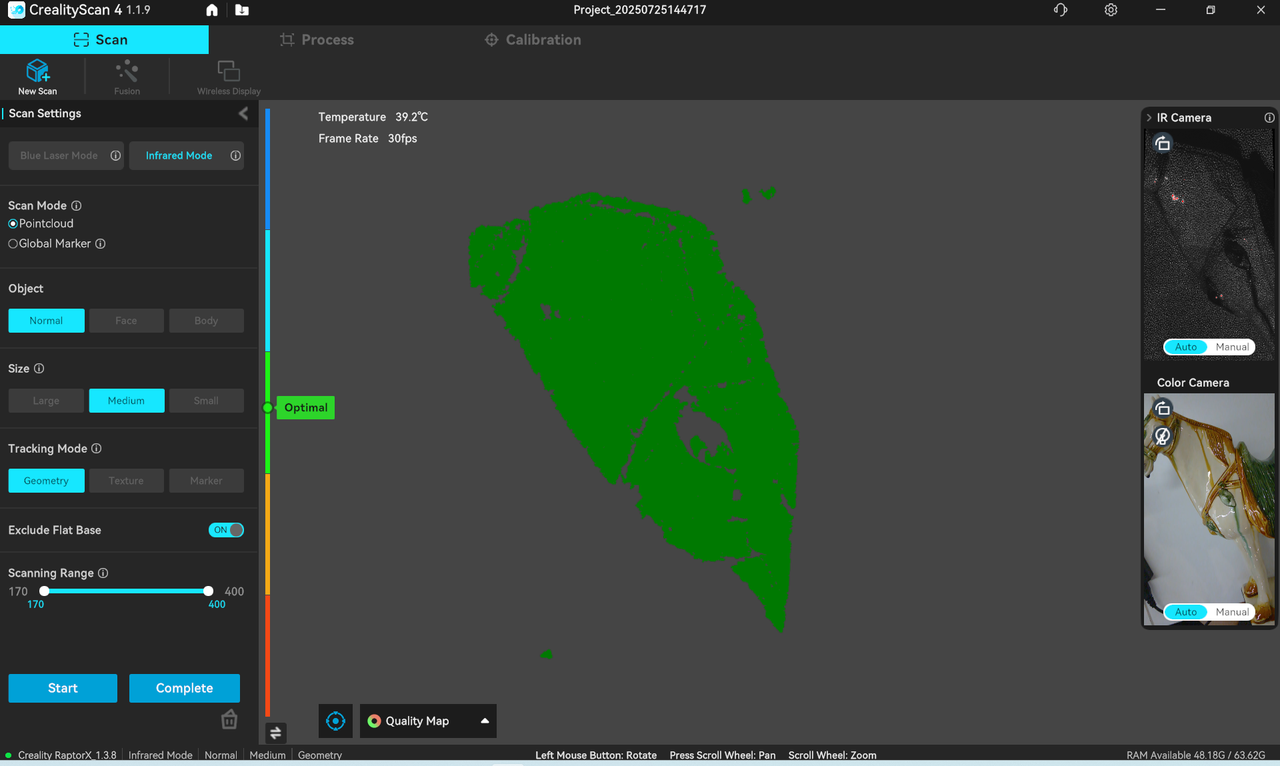
The following is a description of the real-time scanning interface:
-
Depth camera preview window: The upper right window displays the depth camera's IR (infrared) image.
Switch to "Manual" mode to manually adjust the IR exposure for optimal point cloud quality. IR exposure defaults to automatic (for large objects, human figures, or faces). If automatic exposure isn't satisfactory, switch to manual exposure and adjust the image to normal exposure (no blue or red) for better results. -
RGB camera preview window: The lower right window displays the color image of the RGB camera.
RGB exposure can be adjusted automatically or manually to obtain satisfactory RGB image effects. -
Distance indicator: On the right side of the scan settings. When the distance between the scanner and the scanned object is at the "optimal distance", the point cloud acquired is optimal and the tracking stability is the best. When scanning, please pay attention to the reminders on the distance indicator bar to keep the scanner within the optimal distance range.
The distance indicator can be switched between cursor and histogram modes. Beginner users are recommended to use cursor mode, while expert users are recommended to use histogram mode.
Supports adjusting the distance range of point cloud acquisition. Point clouds outside the range will not be acquired and displayed in the 3D point cloud rendering area. -
3D point cloud rendering area: The main area is used to preview the current frame point cloud acquired by the scanner and the point cloud acquired historically.
In the pause phase, the point cloud can be manipulated when the cursor enters the 3D point cloud rendering area.
| Button | Operate | Remark |
|---|---|---|
| Left mouse button | Press and drag to rotate point cloud | Pause scanning |
| Press scroll wheel | Press and drag to pan the point cloud | Pause scanning |
| Scroll wheel | Scroll to zoom in/out the point cloud | Pause scanning |
Reset view: In the pause phase, after operating the point cloud, the point cloud can be restored to the state when it was paused.
Point cloud rendering mode switching supports switching to three modes: Without Texture, Quality Map, With Texture. The default is "Quality Map". In quality map mode, it is recommended to fully scan until the point cloud of the scanned object turns green before “Complete Scan” and enter subsequent processing. The upper left corner displays the current number of frames acquired, the number of point clouds acquired in history, the current scanner device temperature, and the acquisition frame rate.
- Current status display: The upper left corner displays the number of frames currently acquired, the number of point clouds acquired historically, the current scanner device temperature, and the acquisition frame rate. The lower left corner displays the model, firmware, and scan settings, and the lower right corner displays the available memory.
¶ Blue Laser Mode
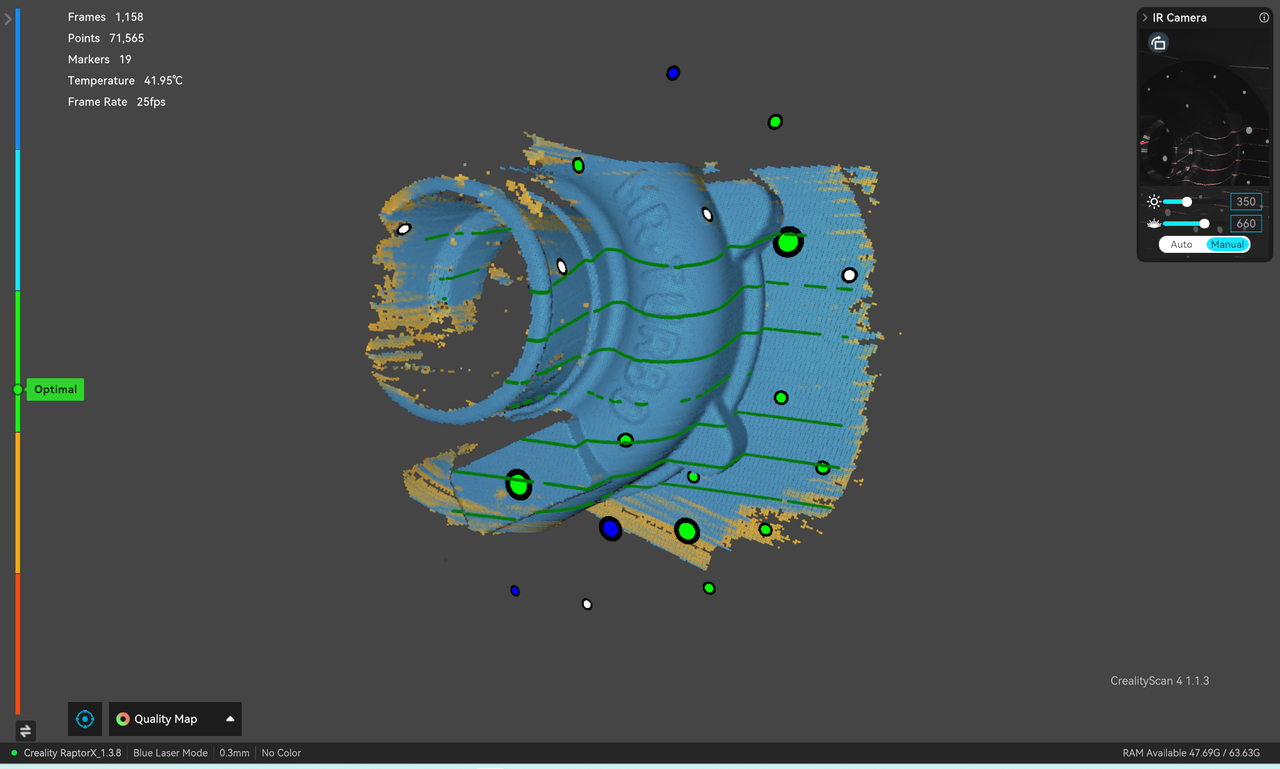
For optimal scanning quality, we recommend using blue laser mode without color mapping.
The main differences from infrared mode are as follows:
- In the depth camera preview window, click to expand the menu to adjust the laser brightness. In semi-outdoor scenes, you can manually increase the brightness to reduce sunlight interference. When adjusting, ensure the window is properly exposed (no blue or red).
- Undo/Redo is not supported.
Blue Laser Scanning Tips:
- During the preview, adjust the IR exposure and laser brightness to ensure the depth camera's markers and laser lines are properly exposed (refer to the picture below. Blue indicates underexposure, red indicates overexposure, and the best state is light white.). Aim the scanner at a feature-rich area of the object and adjust the distance between the scanner and the scanned object to the "optimal distance" according to the distance indicator bar.
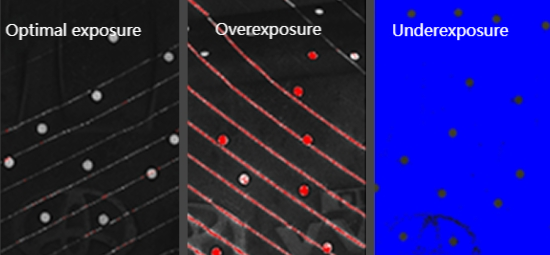
- Click "Start" to start real-time scanning. During the scanning process, while maintaining a relatively fixed distance, slowly move the scanner back and forth towards the scanned part until the point cloud turns blue (Quality Map), then move it back and forth to the unscanned part to continuously ensure normal exposure and "optimal distance".
- Continue scanning according to the on-screen prompts until all point clouds turn blue.

Click "Complete" to end the scan and enter the "Fusion" process.
¶ Infrared Mode
¶ Scanning Tips
- When previewing, ensure that the depth camera preview window is in a normal exposure state (refer to the picture below. Blue indicates underexposure and red indicates overexposure, and the best state is when there is no blue or red.). Aim the scanner at the feature-rich part of the scanned object, and adjust the "optimal distance" between the scanner and the scanned object according to the distance indicator bar.
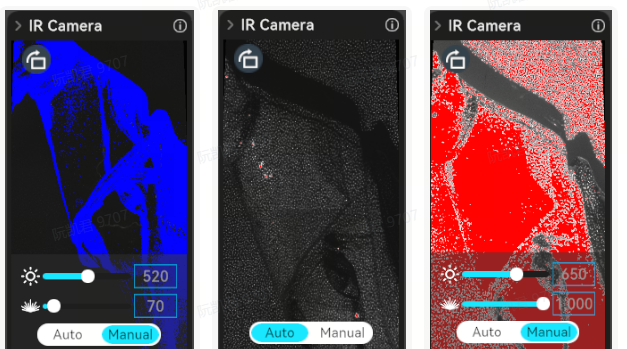
-
Click "Start" to start real-time scanning. During the scanning process, while maintaining a relatively fixed distance, carefully and slowly move the scanner towards the unscanned part of the object, and continue to ensure normal exposure and “optimal distance”.
-
Turn on the "Quality Map" mode, continue scanning according to the interface prompts until all point clouds of the scanned object turn green, indicating that all model data has been acquired and the model quality is high.
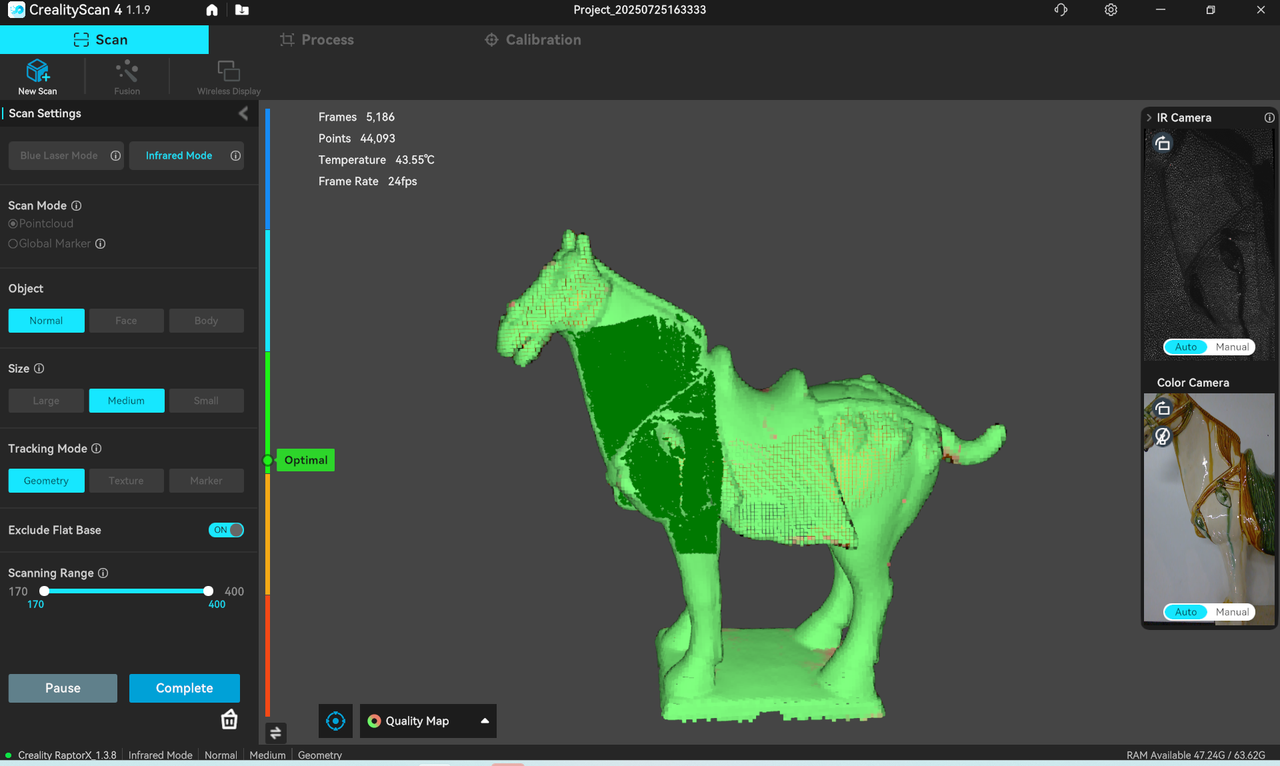
¶ Point Cloud Processing
After scanning is completed, one-click processing or manual processing is supported. The manual processing sequence is Fusion-Mesh-Color Mapping. After point cloud fusion, you can choose to edit the point cloud or use it for aligning multiple point clouds.
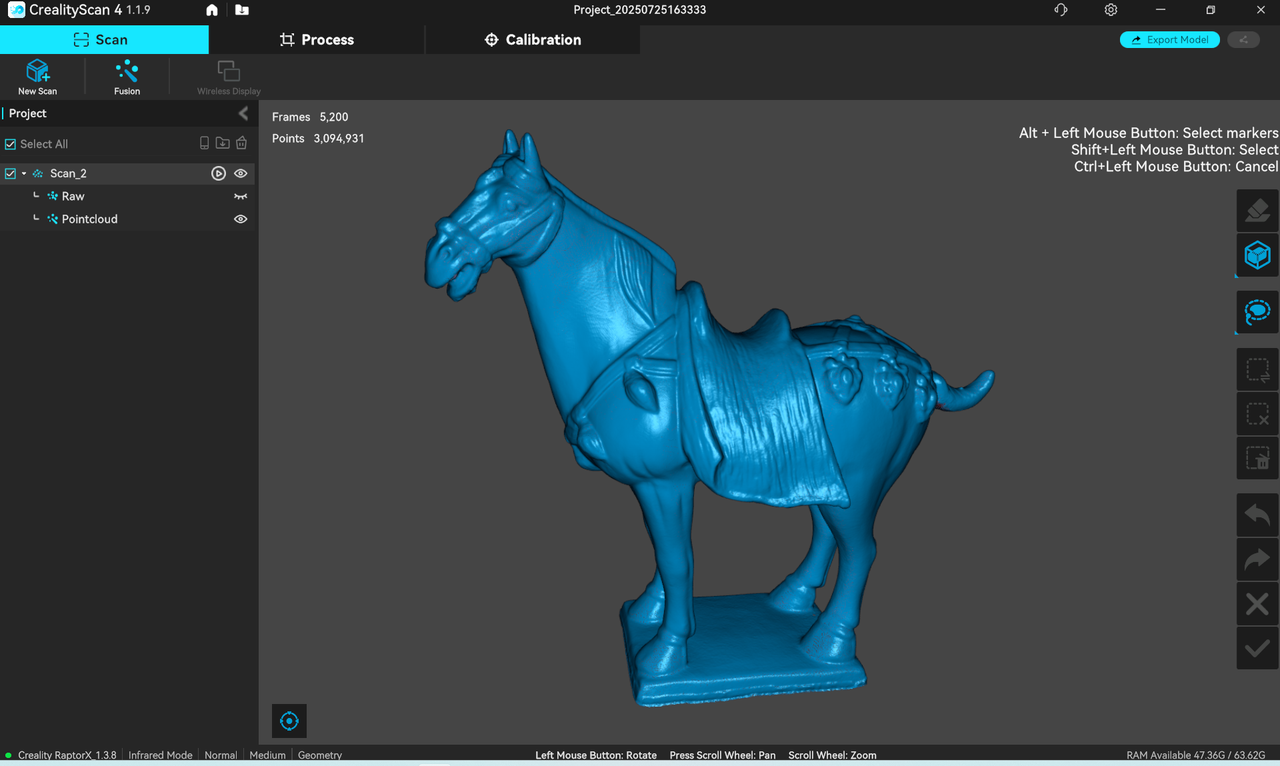
The main window is mainly used to display point clouds or models. The cursor enters the 3D model preview area to operate the point cloud/mesh model, as follows:
| Button | Operate |
|---|---|
| Left mouse button | Press and drag to rotate point cloud |
| Press scroll wheel | Press and drag to pan the point cloud |
| Scroll wheel | Scroll to zoom in/out the point cloud |
The multi-project panel on the left displays the list of currently open multi-projects. Each sub-project unlocks up to three data states during the processing stage: Raw (point cloud), (fused) Pointcloud, and Marker. The Mesh and Texture are displayed separately at the end of the project and can be switched manually. Users can right-click the mouse to delete the corresponding data or rename the project.
There are three buttons in the upper right corner of the project panel:
- Import a mobile project from your phone as a subproject of the current multi-project.
- Import a previous project as a subproject of the current multi-project.
- Delete the current subproject.
¶ Fusion
Click "Fusion" on the scan page to enter the point cloud fusion interface.
Point cloud fusion creates a better 3D point cloud model. There are two ways to achieve this. Standard mode provides a more complete mesh, filling small holes but taking longer to process. Fast mode provides a higher mesh fidelity, more accurate edges, preserves more holes, and reduces processing time.
- A smaller resolution setting yields greater detail, but requires more memory and processing time.
- A higher point cloud confidence level preserves more points.
Removing markers optimizes the mesh at the identified marker locations. Marker removal is enabled by default for marker-based scanning modes.
¶ Meshing
Click "Meshing" on the process page to enter the meshing interface.
Map the scanned 3D point cloud data into a mesh. Users can set parameters such as the maximum number of triangles, smoothing level, whether to fill small holes, whether to remove markers, and whether to close the model.
- A higher smoothing level results in a smoother mesh.
- "Fill Small Holes" automatically fills holes in the model.
- The "Closed" mode automatically generates missing surfaces in the model, generating a geometrically closed 3D model. The non-closed mode will not automatically generate missing surfaces.
¶ Point Cloud/Mesh Editing
The editing toolbar is located on the right side of the main area.
After the scan is completed, the, original point cloud and fused point cloud can be edited and processed. The editing toolbar is located on the right side of the main area. Similarly, the meshed model can also be edited and processed (click the "Edit" button in the upper toolbar to perform "Mesh Simplification", "Mesh Smoothing", or "Hole Filling" operations.)
 Penetrate selection:Supports selecting the point cloud behind the selected area.
Penetrate selection:Supports selecting the point cloud behind the selected area.
 Surface Selection:Only supports selecting point clouds on the surface of the selected area.
Surface Selection:Only supports selecting point clouds on the surface of the selected area.
 Lasso select
Lasso select
 Rectangle select.
Rectangle select.
 Invert Selection.
Invert Selection.
 Unselect.
Unselect.
 Delete, delete the selected part.
Delete, delete the selected part.
 Undo,undo the last deletion operation.
Undo,undo the last deletion operation.
 Redo, undo the last deletion operation.
Redo, undo the last deletion operation.
 Exit.
Exit.
 Confirmed。
Confirmed。
¶ Multi-project Alignment
When there are at least two fused projects in the multi-project panel, click "Alignment" on the process page to enter the alignment interface.
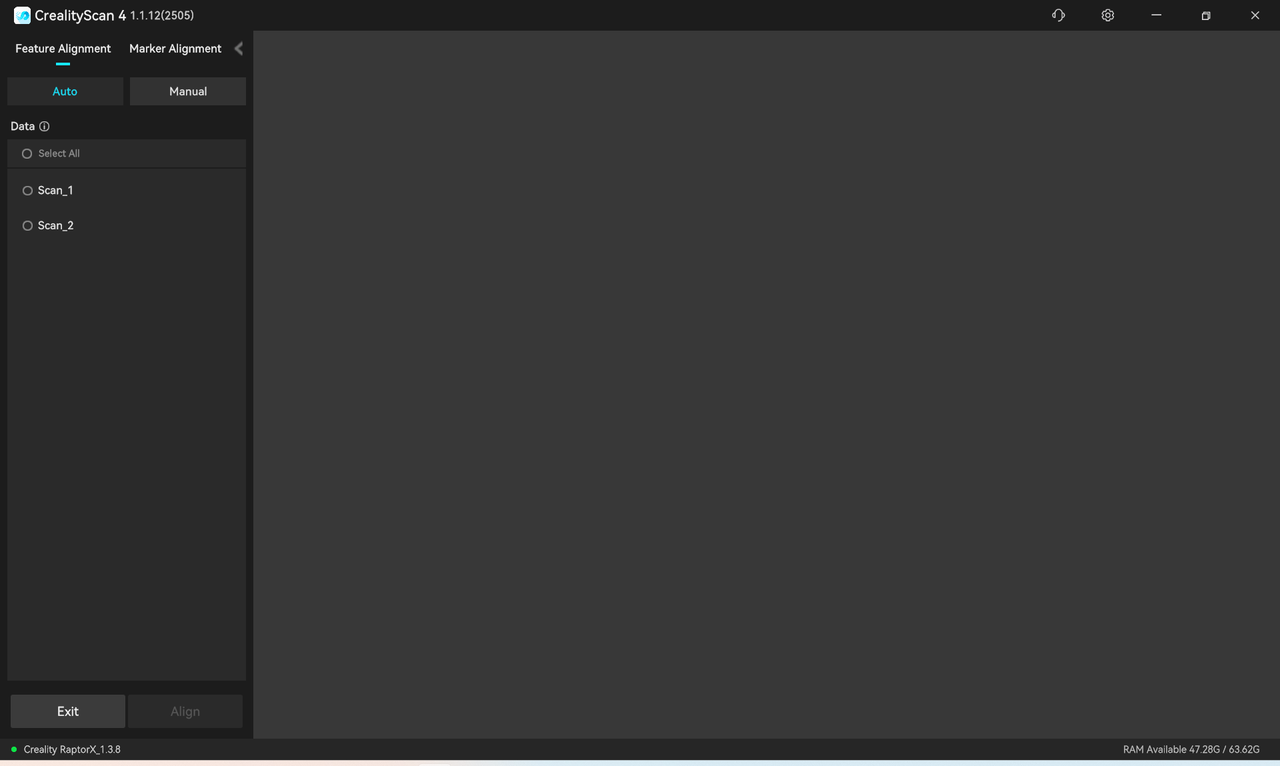
Multi-project alignment offers four modes: auto feature alignment, manual feature alignment, auto marker alignment, and manual marker alignment. You can switch between these modes at the top of the left list.
- Auto alignment (feature and marker) requires sufficient overlapping features or markers between two models.
- Manual alignment (feature and marker) requires at least three pairs of corresponding points on the fixed and floating window models.
¶ 1.Auto Feature Alignment
The left sidebar is the model list. In the auto feature alignment mode, select two target alignment sub-projects in the model list, then click "Align" and wait for the alignment to complete.
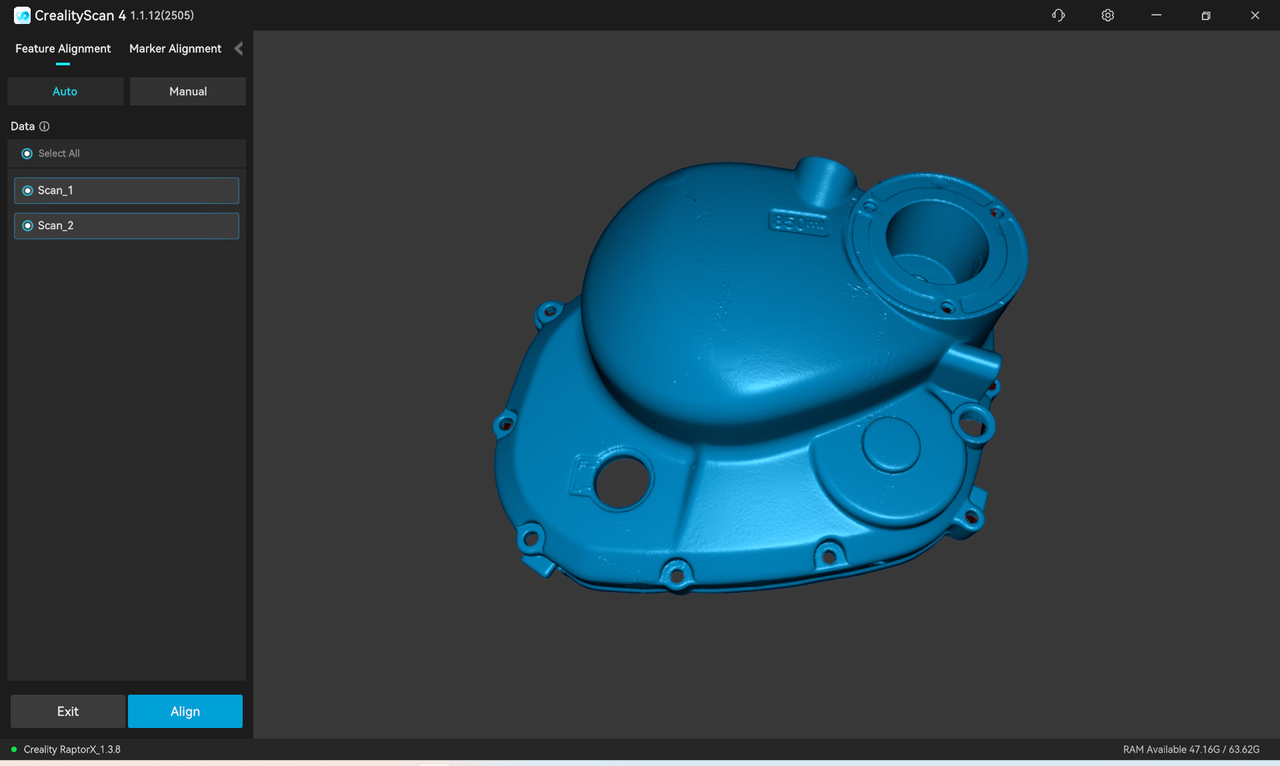
¶ 2.Manual Feature Alignment
The left sidebar displays a list of fixed and floating windows. In the manual feature alignment mode, select a sub-project to be aligned from each of the two lists on the left and display it in the corresponding fixed and floating windows. Then, select at least three pairs of matching points on the models in the fixed and floating windows.。
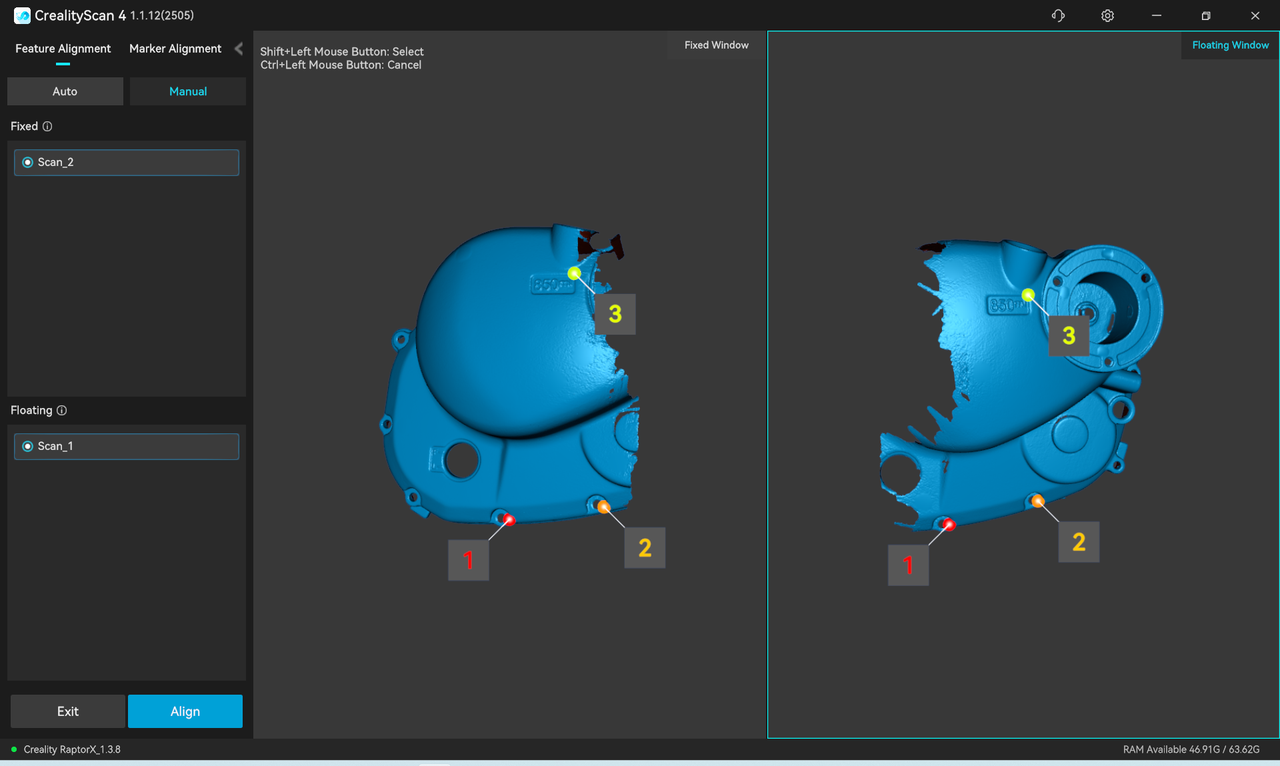
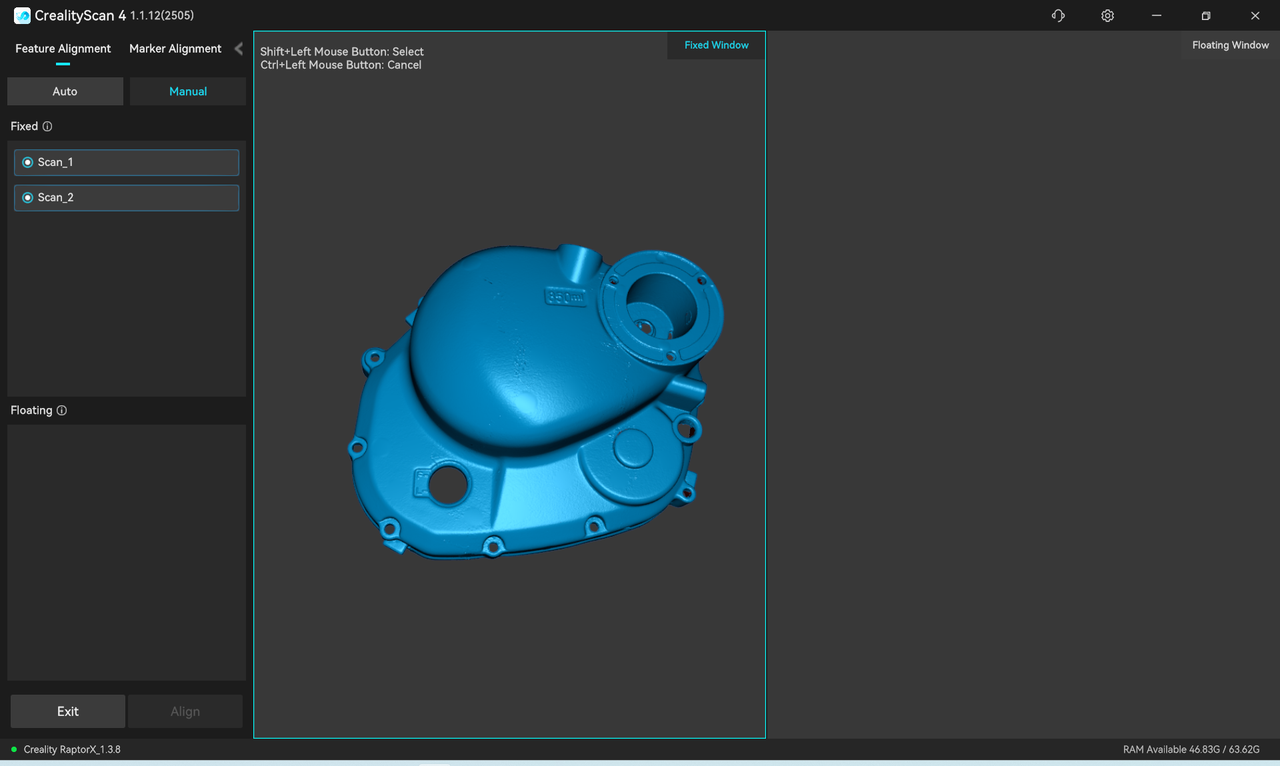
¶ 3.Auto Marker Alignment
The left sidebar is the model list. In the auto marker alignment mode, select two target alignment sub-projects in the model list, then click "Align" and wait for the alignment to complete.
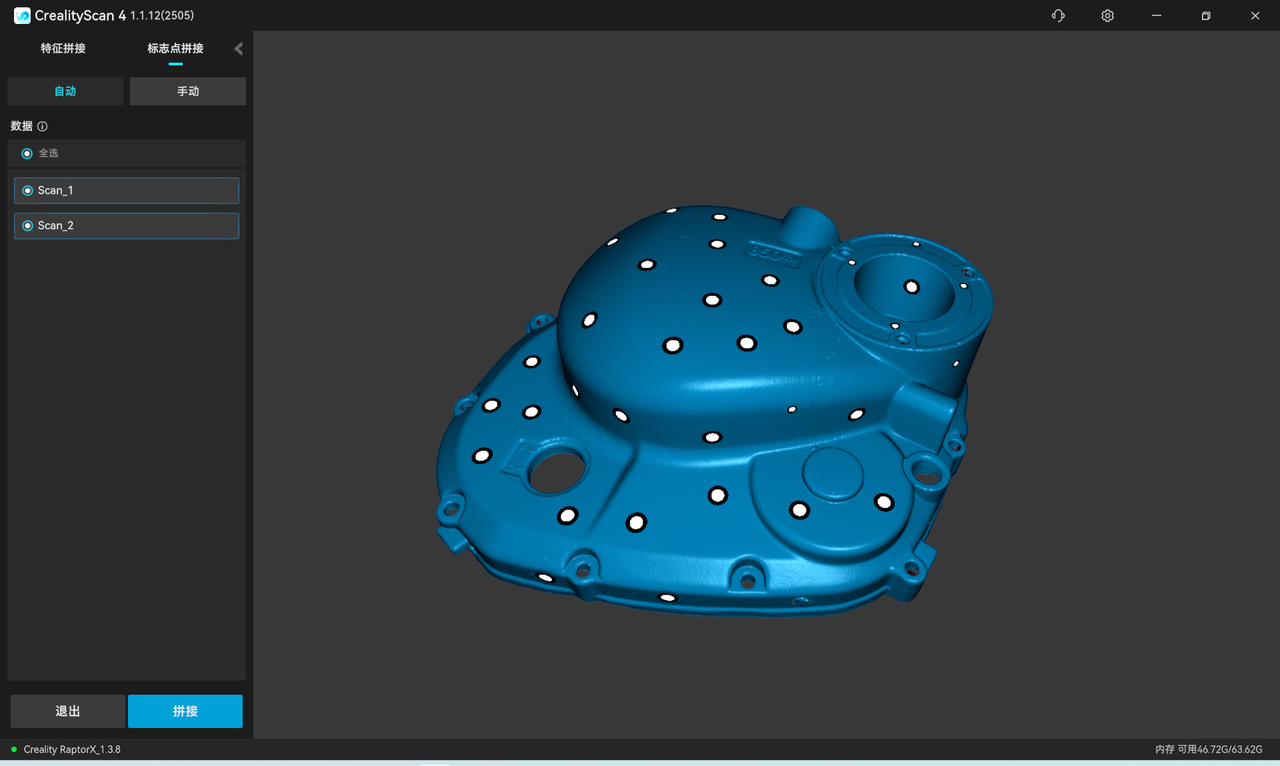
¶ 4.Manual Marker Alignment
The left sidebar displays a list of fixed and floating windows. In the manual marker alignment mode, select a sub-project to be aligned from each of the two lists on the left and display it in the corresponding fixed and floating windows. Then, select at least three pairs of matching markers on the models in the fixed and floating windows.
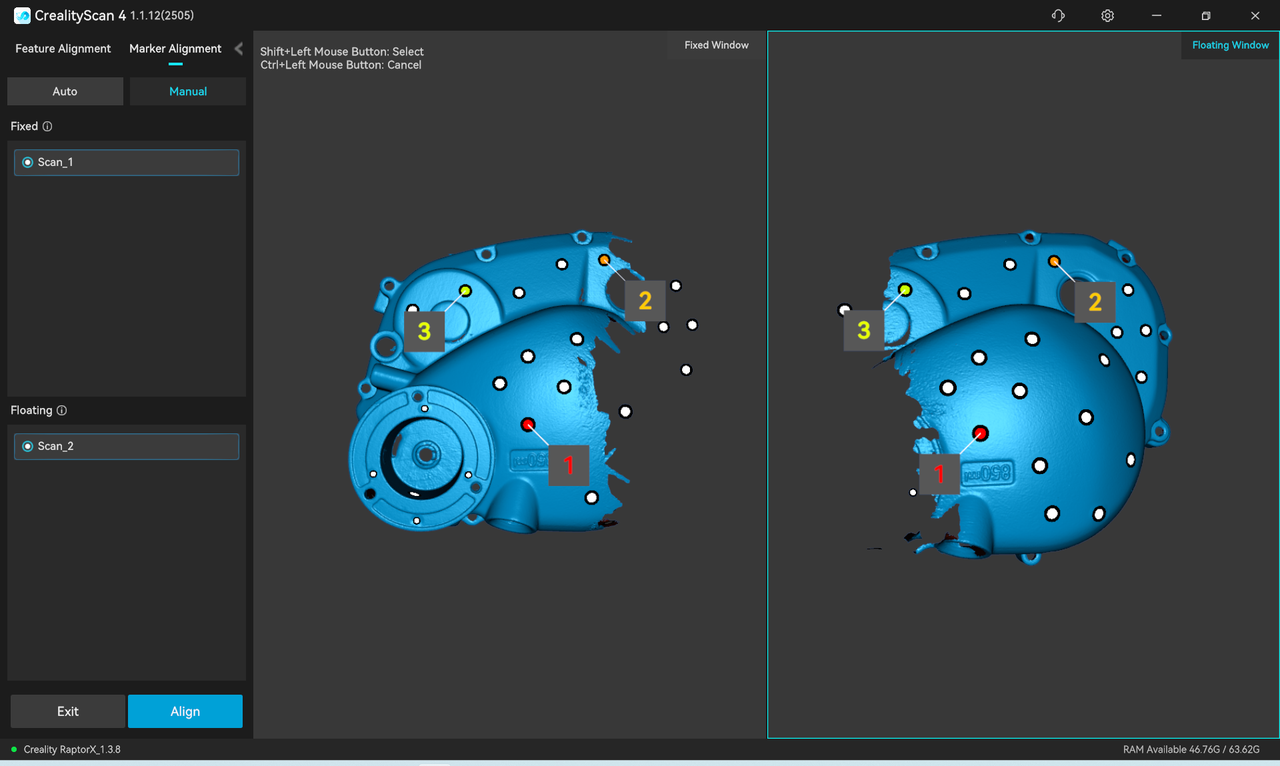
Finally, click "Align" and wait for it to complete.
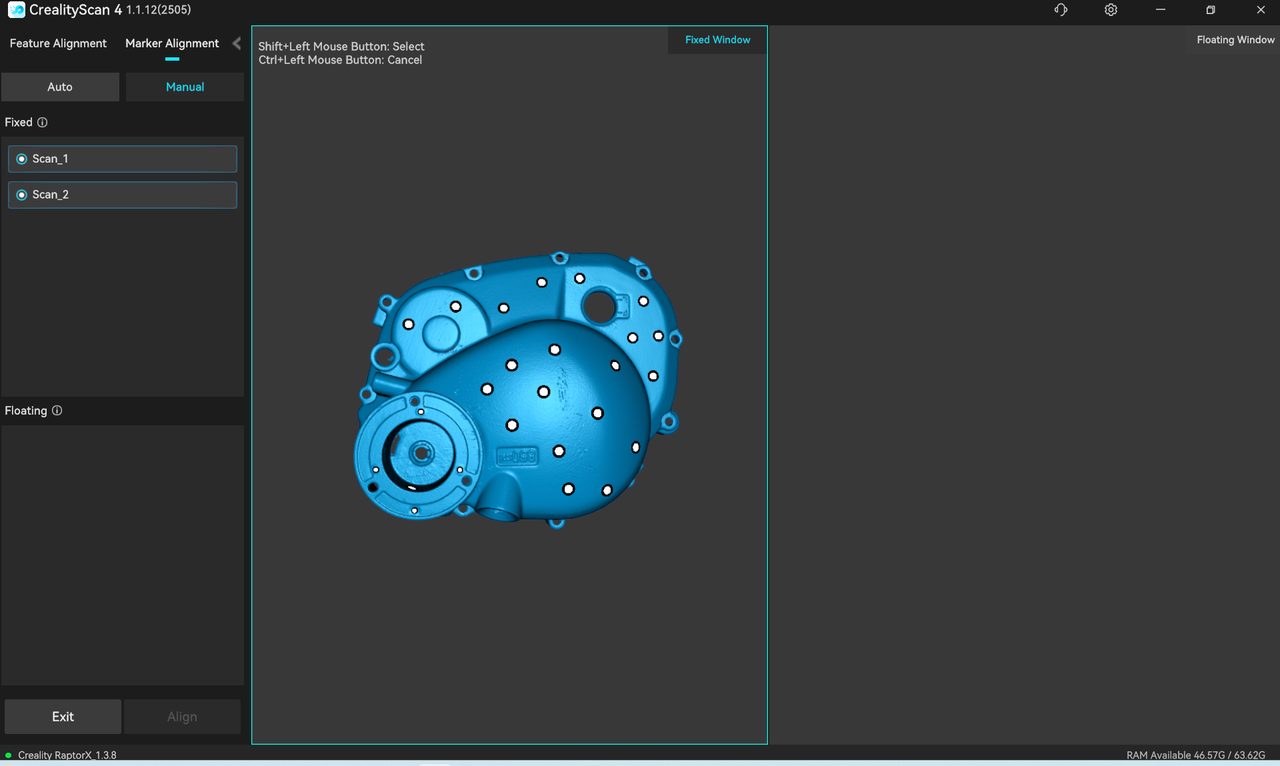
After confirming the alignment result, users can continue aligning two by two or click "Exit" to leave the alignment interface.
¶ Color Mapping
Matches the pixels of an image on a mesh model to improve texture and color resolution.
Export the completed 3D model. The fused point cloud can be exported in .asc and .ply formats, while mesh and texture can be exported in .stl, .obj, and .ply formats. Texture images can only be exported in .obj format with attached texture.
¶ Firmware Upgrade
Firmware upgrade is divided into automatic detection upgrade and manual firmware upgrade.
- When inserting the scanner, if the software is connected to the internet, it will automatically detect whether the scanner firmware version needs to be upgraded, and the upgrade can be performed after confirmation.
- To manually upgrade the firmware, go to "Settings - Firmware Upgrade" on the top bar, download the corresponding latest firmware from the download link and click "Select File" to load, then click “Update” to complete the operation.
